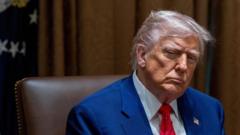Last week, President Donald Trump unveiled an ambitious tariff initiative that promised to reshape global trade dynamics and alter longstanding relationships with US allies. However, following significant backlash, most of these higher tariffs have been suspended for a 90-day period, leaving questions about their potential impact on Trump’s overarching trade objectives, particularly in light of ongoing tensions with China.
Here's a breakdown of Trump's main trade aspirations and their current statuses:
1) **Negotiating Better Trade Agreements**
Trump has repeatedly claimed that the US has been exploited by trade partners, asserting that his administration would reclaim fairness in trade. His sweeping tariff proposal, initially including a 10% baseline rate applicable to all countries, created a stir globally. Allies and rivals alike were forced to consider concessions to avoid the looming economic fallout. Recently, the White House indicated robust engagement from international leaders, citing over 75 countries seeking to negotiate. While the specifics of these discussions have been sparse, ongoing dialogues with countries like South Korea and Japan offer a glimmer of hope for achieving more favorable deals. The real question is whether these partners can meet the strict 90-day deadline to achieve significant agreements.
2) **Revitalizing American Manufacturing**
Trump’s vision includes revitalizing domestic industries through tariffs meant to shield US manufacturing from foreign competition. Yet, the instability stemming from fluctuating tariff policies may deter businesses from making long-term commitments to reinvest in American soil. Consequently, with tariffs frequently shifting, companies may adopt a "wait and see" approach rather than committing to new production facilities, hampering the very economic resurgence Trump aims to instigate.
3) **Confronting China**
Central to Trump's trade strategy is addressing the trade imbalance with China, often regarded as the primary antagonist in US trade issues. Although Trump remains critical of China’s role in the economic landscape, with his aides framing the tariffs as necessary punitive measures, introducing a trade war with a major global power poses significant risks. As both sides assess their thresholds for economic pain, the potential to alienate crucial allies becomes evident, raising discussions about maintaining coalition support in the global arena.
4) **Generating Revenue**
During his campaign, Trump touted tariffs as a means to introduce substantial revenue streams to mitigate the national debt and finance tax reforms. The Tax Foundation previously estimated that a 10% tariff could yield $2 trillion over a decade. While maintaining these tariffs could provide the anticipated revenue boost, shifts in domestic manufacturing away from imports could eventually taper that income, presenting a mixed outlook for his fiscal promises.
5) **Consumer Pricing Impact**
A pivotal aspect of Trump’s narrative is the belief that bolstering American production would lead to reduced consumer prices. However, economic forecasts suggest that tariffs could inversely inflate prices for households. The Tax Foundation estimated that a blanket 10% tariff may escalate costs for American families, eroding the very purchasing power Trump aims to enhance. Lower-income consumers are predicted to bear the brunt of these price hikes, potentially undermining public support for his agenda.
As Trump navigates this precarious path marked by tariffs, negotiations, and public sentiment, whether he ultimately succeeds in realizing his trade ambitions remains to be seen. The implications for both the US economy and the political landscape will be profound as developments unfold.




















